Notes from Miss Alena
“Our care of the child should be governed, not by the desire to make him learn things, but by the endeavor always to keep burning within him that light which is called intelligence”.
Maria Montessori
This month, the school was full of Thanksgiving spirit. I think that the “I am not a Turkey” family project was the biggest hit of the month. So many “disguised” turkeys were created by the kids and their families. So many different characters, so much creativity, energy and family time were involved! We had several Ballerinas and Fashion Ladies turkeys, Fall leaves pile turkey, FedEx and Train Engineer turkey, Chicken and Lamb turkey, Shark and Zebra turkey, Veteran and Marine turkey, Gymboree turkey, Bulls and BlackHawks turkey, Nascar Driver (Jeff Gordon) turkey, My hobbies turkey; Santa, Rudolf the Reindeer and Christmas Tree turkey, Easter Bunny turkey, Hawaiian turkey, Angry Bird and Queen turkey and many others.

Then we continued with a Giving with Gratitude Week, when kids and their families were able to donate food and other items to the 22nd Annual Community Harvest, which will benefit clients of the Crystal Lake Food Pantry as well as the Jaycees’ Share a Christmas program. Together we collected and donated 453 pounds of food and other items. It was a great chance to teach our students not only the importance of giving thanks for what they get, but also the importance of giving.
Thank you everybody who participated in both events and gave our kids a chance to feel the Thanksgiving spirit
We concluded November with a Thanksgiving Activities Morning, where the children prepared a small surprise to thank their families for giving (we hope that you enjoyed it!) and then spent wonderful time together with music and a light snack. Thank you to all parents who joined us and helped.
I hope everybody enjoys the long Thanksgiving weekend with family and friends!
Warmly,
Miss Alena
Working with Montessori materials:
Montessori Grammar Boxes in Elementary class.
The Montessori Grammar Box material consists of eight grammar boxes with colored compartments representing the following parts of speech: article, noun, adjective, verb, adverb, preposition, pronoun, conjunction and interjection. The colors of these compartments do not necessarily match that of the grammar symbols to prevent memorization of colors by the children. The materials used along with the grammar boxes include sentence cards, word cards and grammar symbols.

An elementary student receives presentations with the grammar boxes usually following work with some of the other Montessori Grammar Games (one to many, logical partners, envelope and chart work, etc.).
The purpose of the grammar box is to explore the different types of adjectives, verbs, adverbs etc. For example, when a child is working with adjectives they will fill the box with a phrase card that contains, “the blue pencil, the red pencil and the brown pencil.” The child would bring these three pencils to their rug, lay out the cards “the” and “pencil”, and replace only the adjective to label each object. At this point the guide or teacher would point out the order of the phrases. He or she might ask the child if the meaning of the phrase changes or does it still make sense if it were, “the pencil blue.” This would be an opportunity to discuss the importance of word order in sentences.
Other concepts taught using the Adjective Grammar Boxes might be sense of color, sense of size, sense of shape (incorporates the subjects of language and geometry), sense of touch, sense of hearing, smelling, tasting, logical adjectives, and comparison of adjectives.
As with most Montessori materials, the idea is once again hands on and builds upon previous knowledge. Follow up work for this material might be writing the phrases that were built in the child’s language journal and symbolizing the parts of speech used in the phrase or sentence.
Ms Katy
Vocabulary Development Sequence Cards.

Material: Several sets of cards showing a sequence of actions in three or more pictures.
The language experience begins with materials that “train the ear.” They encompass a wide variety of activities from storytelling to the silence game. At this time, the child develops listening skills. The directress takes part in information giving conversations and lots of naming is done throughout the classroom. Language specific activities such as: matching and rhyming cards and sequencing cards can be presented to the child.
Sequencing cards show a process from beginning to end. Simple sequencing stories have three or four pictures, more complex stories will have more. The teacher begins by telling the story to the child while setting the cards randomly on the table. The teacher will then retell the story while setting the cards in order from left to right. Later, the cards are mixed and the child is invited to tell the story and lay out the cards. When three or more pictures are mastered, longer stories are introduced to the child.
The direct aim of the sequencing cards is to develop visual discrimination, develop language skills, and to learn sequence and causality. Indirectly it helps to prepare the child for reading and writing.
Miss Patty
Working with Montessori materials:
The Rhyming Words

For young children, learning to rhyme is a reading readiness skill. It teaches both sound and letter patterns necessary for reading and spelling. One exercise we use with the sandpaper letters (as well as other materials) is to construct ending sound words, changing the beginning letter only. For instance, "Let's make an "at" book......the letters "a" and "t" make the sound "at"; by changing the beginning sound only, we create cat, hat, mat, sat, etc.This is part of phonological awareness which is the recognition of sound structure in language.
Counting a word's syllables and separating the beginning sound from its ending, is a necessary step in the reading process.
This skill also builds memory pathways in a young child's brain...think of the patterning used by Dr. Seuss! It reinforces repetition and writing success. Nursery rhymes, songs and poems also contribute to this process.

Sometimes, we read a rhyming book and pause during the story to an immediate response from the class to finish the rhyme in the sentence. An example is from "Chicka Chicka Boom Boom" will there be enough.......and the class loudly responds with "room"!
Rhyming teaches children how language works, the rhythm of language, prepares them to make predictions, writing common letters and to expand their imaginations.
Miss Christine
Notes from the Elementary Class (North room):
Ms. Katy

Happy Thanksgiving! I hope you all enjoyed the gratitude boxes that the class painted and sent home. We kept one gratitude box in the classroom that the children enjoyed filling the week of Thanksgiving. This is something we will continue to do in our classroom throughout the year. I also want to say thank you for sending in items for the Crystal Lake Food Pantry!

We wrapped up our Great Lessons this month. The children enjoyed exploring the Timeline of Life, learning about the small amount of time people have been around when compared to the age of Earth, comparing how language and numbers have evolved over time and many other concepts.

Following the Fifth Great Lesson, one student started a discussion about creating their own Great Lesson. This got all the children talking and brainstorming. Because of their interest in this idea, we decided to abandon my plans for a few days and follow their interest. The next day when they arrived in the classroom, they were able to explore books, cards, and other materials that had to do with the lessons taught. Here is a list of some of the activities observed over those few days: learning about how people obtain food, timeline of transportation, timeline of human shelter, rock and mineral research, Timeline of Life, writing with quills, exploring how written language and numbers have changed over time, space research, fossil and shell exploration and learning about different religions.
A few second year students took it upon themselves to write written research reports and present a “Great Lesson” of their own to the class. It was truly amazing to see what a child can prepare and present if they are doing it because they are interested in it and are given the necessary tools in order to be successful.

Our field trip this month was to the Elgin Public Museum to learn about rocks and fossils. We were presented with different types of fossils and learned a little about the three different types of rocks and how fossils are made. We also learned about the Illinois State Fossil: The Tully Monster!
I would like to thank the parents that drove for this trip and those who volunteered.
December will be a short and busy month. The children will be researching different December holiday celebrations from around the world. This work will be on display at our Classroom Winter Celebration. At this celebration you will be able to view these projects, hear some holiday poems, share in some holiday music and snacks. I look forward to seeing you all there!
A small sample of lessons this month:
Group Lessons: Past, Present and Future, AM/PM, Botany Experiments, Parts and Types of Stems, Asia Biomes, Geography Experiments
Math - First Years: Addition Strip Board, Short Chains (Skip Counting), Addition Finger Chart, Dynamic Golden Bead Addition and Static Golden Bead Subtraction, Measuring with Inches, Telling Time, Money Counting
Math - Second Years: Addition of three, four digit addends with the Stamp Game, Stamp Game Subtraction, Subtraction Facts, Measuring with Inches, Consecutive and Adjacent Lines
Language- First Years: Noun Logical Partners, Article to Object Matching, Adjectives to Describe a Noun, Story Writing with Adjective Envelope, Sight Word Practice, Blue Series Spelling Activities
Language- Second Years: Compound Words, Adjective Grammar Boxes, Parts of Speech Symbolizing, Long Vowel/Short Vowel Sorting, Descriptive Paragraphs, Cursive Writing Practice
Botany: Types of Seeds, How Seeds Travel, Parts of the Stamen and Pistil, Parts of a Flower, Parts of a Seed
Geography and History: Timeline of Life Research, North America Biome Comparisons, North America Continent Map, North America Plants and Animals, Animal Research
Art and Music: Clapping Different Rhythms (ask your child about the hamburger song), Types of Musical Instruments, Painting a Picture of a Family Member, Art Card Matching (Georgia O’Keefe), Volcano Painting
Miss Katy
Kindergarten Extended Day News
The kindergartners enjoyed their first walking field trip to the Crystal Lake library. We got to practice our skills of how to walk safely with a friend, the importance of being aware of our surroundings, and listening to directions. They all did such a wonderful job! During story time, we learned about nocturnal and diurnal animals. We also enjoyed a personal tour of the children’s library. They were amazed that they could find books to read about the presidents, maps, and even Star Wars!

This month we have been studying about the Pilgrims and Native Americans. We read the book, “If You Sailed on the Mayflower in 1620” and discovered many interesting facts about the lives of the Pilgrims and Wampanoag Indians. So many things were left behind when the pilgrims set out for the new world. For example children could not bring all of their toys and clothes with them, women brought materials to cook with, and men normally brought supplies for hunting and building. The children wrote in their journals about the items that they would bring with them on a long journey. We also completed a short book about the Pilgrims that included mapping the Pilgrims’ voyage, reading about the help provided by the Wampanoag Indians, and learning about the first Thanksgiving. The children are excited to be able to share the book with their families.
For Veteran’s Day, our friend Joe shared with us the books that he completed about the Revolutionary War and World War II. We learned that Joe’s Great Grandpa was a prisoner of war in Germany!

The Kindergarten group continues to make great strides in all areas of academics. Puzzle maps continue to be a work choice for many of the kindergartners with maps of Australia, The United States, and Europe being completed this month. Often the children choose to extend this work by drawing flags of the countries or studying about the animals, people, and landmarks of the continents.
In the math area, the children have been working with the bead cabinet. These are bead chains from 1 to10 squared and 1 to 10 cubed.
This work solidifies a child’s ability to count sequentially, uses visual discrimination to discern numbers, and gives the child hands on experience with skip counting.
It was a pleasure to meet with you at the parent/teacher conferences. The kindergarteners have become wonderful role models in the classroom!
Miss Patty
Notes from the South Classroom
Ms. Patty, Ms. Ambreen

We are learning about the numerous holidays celebrated around the world this time of year!
We began the month of November learning about the Indian celebration of Diwali. Diwali, commonly known as the Festival of Lights, is celebrated throughout India between mid-October and mid-November. During this popular holiday, people throughout the country light lamps in hopes that Lakshmi, the goddess of wealth, will bless them with good health, happiness and success in the upcoming year. Simultaneously, individuals wear new clothes during prayers, symbolizing a fresh start in the New Year. Ms. Laxmi gave a beautiful presentation to the children about the holiday of Diwali-its meaning, significance, and how they celebrate! We learned about lights, firecrackers, presents, and sweets and the intricate clothing that is worn during the celebration.
In the Cultural area of the classroom we have been studying about Pilgrims, Native Americans, and Turkeys. The children enjoyed listening to the story of Samuel Eaton. It is about a young Pilgrim boy that lived on the Plymouth Plantation in 1627. We learned all about the hardships that the Pilgrims endured during their first winter in North America.
We have also been learning about the different Native American tribes of North America. The children created beautiful cave art pictographs! They were so excited to be able to examine real Native American artifacts such as; arrowheads, beads made from rocks/shells, dream catchers, and talking sticks.

We also learned that there are eight different types of turkeys. The feathers of the turkey have had used as writing instruments and Indian headdresses. It takes over 4,000 turkey feathers to create Big Bird’s costume! The use of 3 part cards helped us learn the different parts of the turkey. Did you know that a turkey has a beard? We also enjoyed seeing all the “disguised” turkeys hanging in our hallway! Thank you for helping your child with this family fun project!

The children are asked how they would move their bodies to words such as gusty, flop, flippy, spout, and spouting. They can move certain parts of their body such as the upper half (trunk, ribs, arms, shoulders, head) or the lower half (hips, waist, legs, feet) or they can move just their arms, legs, hands, etc. We recite the poem and allow the students to move in their own self space or with a partner or with the entire group. They are also encouraged to move with the syllables in each word- such as moving ( clapping, stomping, blinking, hopping, etc.) twice to spouting , gusty, or flippy and once to flop or spout. This activity not only involves the whole body but it also is a great vocabulary/language builder as it reinforces body awareness skills and literacy skills.
In the language area, the children have been making a variety of “books”. Many have made their own story books such as; Mr. Toad and Mr. Fish.

The younger children dictate the story to the teacher and the older child uses the moveable alphabet to phonetically write out their story. They are then given the opportunity to “read” their books to the class.
The new readers have been using the quiet area to practice their reading skills with friends. Once the children learn a new sound or word, they want to share this new found knowledge with everyone!
In Math, the children have been looking forward to estimating how many gummy bear packs are in the estimation jar. They have been examining the jar each day and have noted that it feels much heavier this month. Does that mean that there are more items in the jar?
We also tasted 3 different types of pears…Bosc, Bartlett, and Red. Afterwards we graphed the results and learned that most of us preferred the taste of the Red pear with the Bosc pear a close second!
In the sensorial area, the children have been using the red rods to make mazes, which they carefully walk through, being careful to not touch the rods and using the brown stairs and pink tower to build many different patterns. The children often work with a friend when using these materials which helps them learn how to plan and cooperate and collaborate with each other in order to complete the work.
Thank you for attending the parent/teacher conferences. It was a pleasure to speak to each of you about your child’s development in the classroom!

Thank you to the parents and grandparent that helped with the Thanksgiving craft day! A fun time was had by everyone!
Owen and Ms. Ambreen celebrated their birthdays this month!
We would like to thank everyone for their generous donation to the local food pantry.
“At times our own light goes out and is rekindled by a spark from another person. Each of us has cause to think with deep gratitude of those who have lighted the flame within us.”
— Albert Schweitzer
May your family experience bountiful blessings during this month of gratitude and beyond,
Ms. Patty, Ms. Ambreen, and Ms. Jennifer
Notes from the East classroom
Ms. Christine, Ms. Laxmi
Thank you so much for making our November truly a month of giving and sharing not only within our classroom, but with others in need in our community. It was heartwarming to open the door in the morning to see how proud your children were bringing in heavy bags of goods to donate to the local food pantry! In our own Montessori community, we enjoyed making special treats of sausage/biscuit rolls, tortillas, cheese and crackers and fresh fruit and vegetables for snacks - thank you for your ongoing Sharing Basket contributions.
Food preparation activities are a popular "work" within the Practical Life area of our classroom.
We learned about the Pilgrims and Native Americans first celebration of Thanksgiving - the journey from England to the first foods that were at their feast as they started this tradition together.
We made corn bread and homemade butter and discussed what each of us enjoys the most with our families on Thanksgiving (do you all really eat pancakes on Thanksgiving? It was a popular favorite).

Thank you Ms. Laxmi for the wonderful presentation of the Indian celebration of Diwali – the festival of lights.

We have expanded our Spanish materials to include the Days of the Week and Spanish fruits names. The children enjoy repeating this information and we plan to implement additional materials regularly.
Many children have enjoyed matching object cards to either Pilgrim or Native American classification categories: who used a canoe vs. sailing ship? who wore a moccasin vs. leather shoe with a buckle? etc. It made for some interesting conversations and observations by the class.

In math, we have introduced several extensions to the 100 board such as number patterns, i.e. turning over every numeral that ends with a "1" and skip counting sequences. Many children have moved up from the solidification of numbers 1 - 10 into the teens and beyond.

Our language area thrives with daily work on phonetic letter sounds, word building, sentence building, reading and solidification of each child's skill set.
Special thanks to Emily's grandma and Addison's "Papa" for joining us and helping with some fun projects on the 26th! The children had fun on this Craft Day making Native American girls/boys, pine cone turkeys and turkey puppets.

Ask your child to sing our Thanksgiving songs "Hello, Mr. Turkey" and "A Turkey is a Silly Bird" songs which we sang together.
We also thank you for bringing in items for the Thanksgiving Blessing mix and sincerely hope you and your families have had a wonderful Thanksgiving celebration with your families!
We continue daily observation and evaluation of each child, and our goal is to keep them interested, challenged and focused at their own, appropriate level with their work.
Happy Thanksgiving!
Sincerely,
Ms. Christine and Ms. Laxmi
Notes from the Pre-K extended class:
Ms. Ambreen

In the month of November, our pre-kindergarten friends were very busy getting ready for Thanksgiving--a special day for showing our gratitude to our family, friends, and community for their love and care.
We worked on our 'I am Thankful' books and a special hand weaved Thanksgiving mat.
In math, we learned how to count by 3s, introduced the decimal system and place value of numbers, continued working with simple addition, and made a polygon chart.
Our vowel of the month was 'O' and we worked on word families using this vowel with combinations of other sounds.

In geography, we learned about our home state Illinois and made books about Illinois. Following the Thanksgiving theme, we learned about the parts of a turkey in science.
Meanwhile in Art, we did snip cutting and created colorful paper Turkeys to decorate our classroom. We also worked on our pumpkin painting and corn craft.
Our recipe of the month was 'Corn Muffins'.
Happy Thanksgiving to all our friends!
Sincerely,
Ms. Ambreen
Notes from the afternoon classroom:
Ms. Donna

The children have worked on making brown squirrels, black owls, Native Americans in canoes, a rug or wall hanging has been started where each child will get to weave a couple of rows to name a few of our art projects.
Games: a small box had a different color on each side; each child had a chance to roll the box and whatever color came up on the top of the box they would point out something that had their color.
We played a Native American sign game (no words aloud). Each child made up a sign to represent them, they would give their sign and then give the sign for someone else, who would give their sign and then give a sign of someone else.

We have a class pet. It is a crocodile (not real). We have yet to give it a name. We have been learning how to use a ruler and a tape measure as we check on how much our crocodile has grown. He began being 12 inches long and now is 25 inches long and so much wider. We have been told it might get to be 3 1/2 feet long.
We wrote our first class book called the PM What I Am Thankful for Book. Each child has his own page. They drew pictures about what they were thankful for.
Outside time has had us using the long jump rope, hula hoops, and with the arrival of snow, the sleds and snow shovels. We were lucky to be out when it was snowing and we caught snowflakes on our tongues.
Sincerely,
Ms. Donna
-
Notes from the afternoon classroom
Ms. Terri
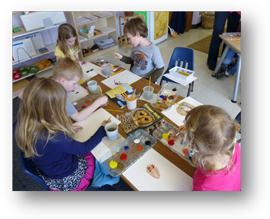 Elementary Art News:
Elementary Art News:
Our species this month is Birds. We chose an owl for this art project. After looking at many varieties of owl we noticed that they all have the color brown in them. So the next week we learned to make the color brown by mixing the three primary colors. It sounds easy but it can be both a fun and frustrating experience. To mix the color brown you use lots of yellow (weak pigment), a little red (stronger pigment) and the tiniest bit of blue (strongest primary). We found out if our color is too purple we add a little yellow, too green we added more red or if we needed a lighter brown we added a little white – you get the idea.
The next week we took the information we had acquired and started our painting. The children drew the owl using basic shapes of circles and ovals. Then, after they had mixed their tempera paints on their palettes, they painted their owls. The challenge after mixing theirs paints was the texture of the owl and figuring out how to use their paint brushes to paint feathers. It was lots of fun and we all decided we need more time for art because it’s hard to stop and time goes by so quickly!
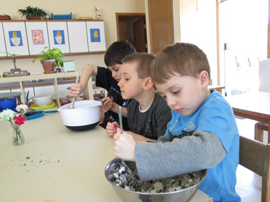 Kindergarten Art News:
Kindergarten Art News:
The kindergarten class looked at the artist Michelangelo this month. The art technique Michelangelo used was called “fresco” or painting on plaster walls and ceilings.
When the plaster is damp the paint is absorbed into the plaster and gives a longer lasting finish to the work.
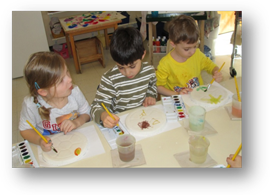
When creating our own frescos, we used round aluminums cake pans as a mold. After mixing Plaster of Paris with cold water we poured the mixture into the mold and waited for the plaster to set. We removed the hardened damp plaster from the mold. Next, we painted a picture of our choice onto the damp plaster with watercolors. The plaster was warm to the touch as it dried and also very smooth on the molded side. We also noticed that the damp plaster has a very absorbent surface and our watercolors did not flow as they do on paper. It was a very fun project as well as a delightful sensorial experience!
Pre-Kindergarten Art News:
The pre-kindergarten class’ favorite project this month was based on the story “Three Bill Goats Gruff.” The story involved a rickety wooden bridge over a stream that has green grass filled with clover on one side and brown, grassless dirt on the other, 3 Billy goat brothers and a troll who lives under the bridge whose favorite food just happens to be goat!
We used colored pencil, crayon, and watercolor and cut paper strips to make our bridge. Then, our special addition was a troll made out of clay – complete with red eyes, fangs, claws and a green body and head. It was a lot of work to soften the clay and mold the shapes but boy did they have fun making their version of the ugly, hungry troll. Since many of the children choose this story at reading time it was extra special to do a project related to it!
Our baking recipe this month was Apple Cinnamon Muffins (which we poured into a 9”x13” pan to make more servings).
Here’s the recipe – enjoy!
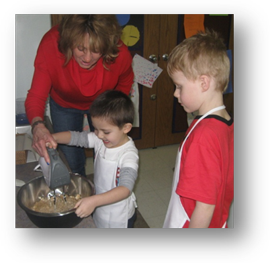
Apple Cinnamon Muffins
2 c. flour
1 t. baking soda
1 t. cinnamon
½ t. salt
2 large eggs
½ c. agave sweetener
½ c. sunflower oil
½ c. milk or dairy alternative
1 t. vanilla
1 c. applesauce
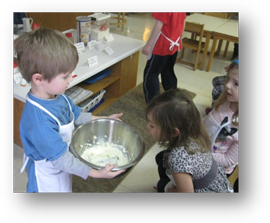
- Preheat oven to 350°
- Grease pan or line muffin cups
- In medium bowl combine flour, baking soda, cinnamon and salt
- In a separate bowl, whisk eggs, agave, oil, milk and vanilla and stir into flour mixture to combine
- Stir in applesauce
- Scoop into pan or muffin cups
- Bake for 18-20 minutes
**Variation: add one cup frozen blueberries for blueberry muffins!
Warmly,
Ms. Terri
